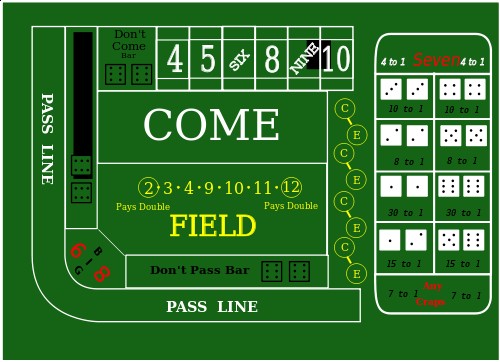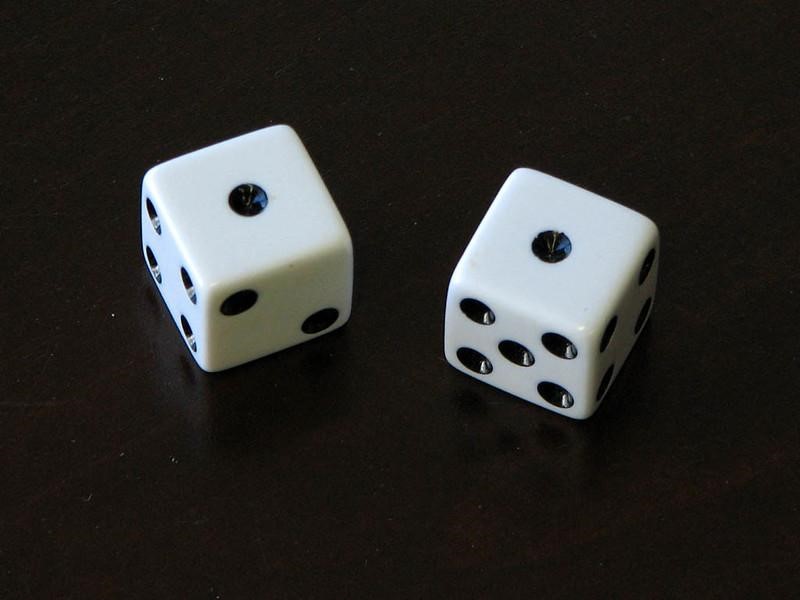How to Play Craps for Beginners
In land-based casinos, you’ll pretty much always find action around the Craps tables. It’s a fast exciting game and with a house edge of only 1.41%, one that gives you a good chance of a big pay-off. But in online casinos it doesn’t seem to have the same appeal.
This might be because players think that online dice rolls can be fixed. Well, let us assure you that online games are just as fair as those in land-based casinos. The numbers that online dice land on are produced by an electronic RNG (Random Number Generator). Physical dice are nothing more than an analogue RNG so playing with real or virtual dice won’t affect the outcome of your roll whatsoever.
The other reason that Craps isn’t such a popular online game could be that, for the beginner, it looks a bit complicated. The mechanics of playing are easy enough, just shake the dice and (click) roll. But the table layout and all the different betting options look a bit overwhelming to the novice gambler. Don’t worry, they’re not. In this Beginner’s Guide to Craps we’ll give you all the information you need to play this fast-paced favourite.
Nobody knows the origins of craps for sure, but we do know that it has been around in one form or another since the Middle Ages at least. That’s because, despite appearances, it’s a very easy game to play. And thanks to innovations introduced in 1907 by one John H Win, a dicemaker from Philadelphia, one of the fairest. Win developed rules that allowed gamblers to bet for or against the shooter. This evened up the odds and made sure there was no benefit to the house in using loaded dice.
But enough of the history lesson. Now we’ll go over the basics of what happens when you step up to the table to take your roll, and then we’ll explain the different betting options.
How to play
In land-based casinos, the dice are passed counter-clockwise to the next player at the start of each new round. The player rolling the dice is called the “shooter”. Their first roll is called the “come-out” roll and here’s how it goes.
- The shooter selects their dice.
- The shooter and players make Pass or Don’t Pass Bets (more about that in a minute)
- The shooter rolls the dice so they hit the far wall of the table.
The result of the come-out role determines what happens next. Depending on the number rolled, this can be one of three things. And remember these terms because they are important for understanding your betting options.
●Natural
If the result of the roll is a 7 or an 11, it’s a “natural” and the shooter wins and gets to roll again.
●Craps
If the shooter rolls a Snake Eyes, meaning a 2, or a 3 or a 12, they lose but get to roll again.
●Point
If the result of the roll is a 4, 5,6,8,9 or 10 this becomes the Point. Now the shooter can roll again, but has to hit the same number before they roll a 7. It doesn’t have to be the same combination of dice as long as the total is equal to the Point. The shooter continues to roll until they hit the Point, which means they win, or a 7, which is a loss and ends the round. This is called “sevening-out”
How to Bet
There are lots of different betting options in Craps, some of them quite complex, involving multiple rolls and combinations But since this is just a Beginner’s Guide, we’ll stick to the basics, starting with the Pass or Don’t Pass bet.
●Pass or Don’t Pass
This bet is placed before the shooter throws their come-out roll. If you bet on the pass line, you’re betting the shooter will win by throwing a Natural or hitting the Point before sevening-out.
Don’t Pass is the opposite. If you bet this way you want the shooter to roll a snake-eyes or a three on the come-out roll, or a seven before they hit their Point. If a 12 is rolled on the come-out, the bet is a “Push”, neither win nor lose.
Like we said, these bets are made on the come-out roll before the Point is established. Once this happens, you move on to Come or Don’t Come bets.
●Come or Don’t Come
These bets can be made at any time after the shooter’s Point has been determined.
A Come bet wins if the shooter throws a Natural. A Craps means it loses. If any other number is thrown, it becomes the Come Bet Point. Now you want the shooter to roll this number again before they seven-out.
Don’t Come bets are more or less the opposite. If the shooter throws a 2 or a 3, the bet wins,12 means it becomes a Push bet. Any other number will become the Don’t Come Point, but this time you want the shooter to seven-out before rolling it again.
●Proposition Bets
Proposition bets can be made at any time in the game and are only good for one throw. You’re basically betting on what the next number rolled will be. This, as you can imagine, gives the house a very high edge. So although proposition bets are exciting and can have a big pay-out, you should only use them sparingly. We’ve listed the bets and the pay-outs below
|
Bet |
Win |
Pay-out |
|
Ace Deuce (three) |
Shooter rolls a 3 |
Pays 15 to 1 |
|
Big Red (seven) |
Shooter rolls a 7 |
Pays 4 to 1 |
|
Any Craps (Three way) |
Shooter rolls a 2, 3 or 12 |
Pays 7 t0 1 |
|
Snake Eyes |
Shooter rolls a 2 |
Pays 30 to 1 |
|
Boxcar |
Shooter rolls a 12 |
Pays 30 to 1 |
|
Yo (eleven, called Yo so it isn’t confused with seven) |
Shooter rolls 11 |
Pays 15 to 1 |
|
Horn |
Shooter rolls 2, 3, 11 or 12. The wager is split equally among the numbers |
Pays 30 to 1 on the 2 or 12, 15 to 1 on the 3 or 11. |
Other Bets
As we mentioned before, there are lots of other bets that can be made in Craps, but most of them involve combinations and are for advanced players so we’ll just wrap up this Beginner’s Guide with some other simple bets.
- Place Bets: Once the Point has been established, you can bet on any other number on the table. If it’s rolled before the shooter sevens-out, you win.
- Field Bets: A one roll bet, you win with a 2, 3, 4, 9, 10, 11 or 12. A 5, 6, 7, or 8 means you lose.
- Big 6 or Big 8: If you have the feeling the shooter will roll a 6 or 8 before a seven, place this bet.
These then are the simplest and some of the most popular bets in Craps. Practice playing and you’ll get a feel for when and how to use them. Then you’ll be ready to up your game and move on to more complex multi-roll bets, which we’ll explain in another blog when the time comes. Good Luck!


